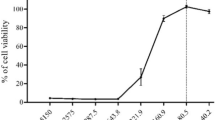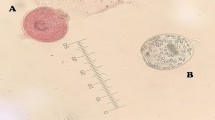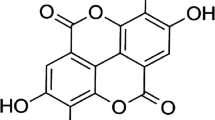Abstract
The negative effects of coccidiosis on poultry health and productivity and increasing problems related to drug resistance have stimulated the search for novel and alternative methods of control. The present study evaluates the anticoccidial activity of curcumin (diferuloylmethane), a natural polyphenolic compound abundant in the rhizome of the perennial herb turmeric (Curcuma longa) which is a spice and food colourant commonly used in curries and also used as medicinal herb. Its effects were evaluated on Eimeria tenella sporozoites, including morphological alterations, sporozoite viability and infectivity to Madin–Darby bovine kidney (MDBK) cells. Morphological alterations of the sporozoites were recorded as deformation due to swelling and cell membrane corrugations. Curcumin at concentrations of 25, 50, 100, 200 and 400 μM showed considerable effects on sporozoite morphology and viability in a dose-dependent manner after incubation over 3, 6, 18 and 24 h while lower curcumin concentrations (6.25 and 12.5 μM) were not effective. In comparison to the untreated control, sporozoite infectivity was reduced at curcumin concentrations of 100 and 200 μM by 41.6% and 72.8%, respectively. Negative effects of curcumin on MDBK cells were not seen at these concentrations; however, curcumin at concentrations of 1,800, 600 and 400 μM was toxic to MDBK cells and affected cell proliferation. In conclusion, curcumin exhibited a marked inhibitory effect in vitro on E. tenella sporozoites inducing morphological changes and reducing sporozoite viability and infectivity.





Similar content being viewed by others
References
Allen PC, Fetterer RH (2002) Recent advances in biology and immunobiology of Eimeria species and in diagnosis and control of infection with these coccidian parasites of poultry. Clin Microbiol Rev 15:58–65
Allen PC, Danforth HD, Augustine PC (1998) Dietary modulation of avian coccidiosis. Int J Parasitol 28:1131–1140
Chan MMY, Adapala NS, Fong D (2005) Curcumin overcomes the inhibitory effect of nitric oxide on Leishmania. Parasitol Res 96:49–56
Chapman HD (1999) The development of immunity to Eimeria species in broilers given anticoccidial drugs. Avian Pathol 28:155–162
Conney AH, Lysz T, Ferraro T, Abidi TF, Manchand PS, Laskin JD, Huang MT (1991) Inhibitory effect of curcumin and some related dietary compounds on tumor promotion and arachidonic-acid metabolism in mouse skin. Adv Enzyme Regul 31:385–396
Cui L, Miao J, Cui LW (2007) Cytotoxic effect of curcumin on malaria parasite Plasmodium falciparum: inhibition of histone acetylation and generation of reactive oxygen species. Antimicrob Agents Ch 51:488–494
Dulski PM (1990) Eimeria tenella—incomplete excystation in the presence of EDTA in a taurodeoxycholate-based medium. J Protozool 37:524–528
Fatumbi OO (1981) Coccidiosis and drug resistance. Niger Vet J 10:63–64
Hermosilla C, Stamm I, Taubert A, Lutz K, Zahner H, Menge C (2008) Fluorescent Eimeria bovis sporozoites and meront stages in vitro: a helpful tool to study parasite–host cell interactions. Parasitol Res 102:777–786
Jayaprakasha GK, Jagan L, Rao M, Sakariah KK (2005) Chemistry and biological activities of C. longa. Trends Food Sci Technol 16:533–548
Kitandu A, Juranová R (2006) Progress in control measures for chicken coccidiosis. Acta Vet Brno 75:265–276
Koide T, Nose M, Ogihara Y, Yabu Y, Ohta N (2002) Leishmanicidal effect of curcumin in vitro. Biol Pharm Bull 25:131–133
Labbe M, de Venevelles P, Girard-Misguich F, Bourdieu C, Guillaume A, Pery P (2005) Eimeria tenella microneme protein EtMIC3: identification, localisation and role in host cell infection. Mol Biochem Parasitol 140:43–53
Lillehoj HS, Lillehoj EP (2000) Avian coccidiosis. A review of acquired intestinal immunity and vaccination strategies. Avian Dis 44:408–425
Mosmann T (1983) Rapid colorimetric assay for cellular growth and survival—application to proliferation and cyto-toxicity assays. J Immunol Methods 65:55–63
Mukhopadhyay A, Basu N, Ghatak N, Gujral PK (1982) Anti-inflammatory and irritant activities of curcumin analogs in rats. Agents Actions 12:508–515
Nakai Y, Ogimoto K (1983) Relationship between amylopectin and viability of Eimeria tenella sporozoite. Jpn J Vet Sci 45:127–129
Nose M, Koide T, Ogihara Y, Yabu Y, Ohta N (1998) Trypanocidal effects of curcumin in vitro. Biol Pharm Bull 21:643–645
Perez-Arriaga L, Mendoza-Magana ML, Cortes-Zarate R, Corona-Rivera A, Bobadilla-Morales L, Troyo-Sanroman R, Ramirez-Herrera MA (2006) Cytotoxic effect of curcumin on Giardia lamblia trophozoites. Acta Trop 98:152–161
Ramirez-Tortosa MC, Mesa MD, Aguilera MC, Quiles JL, Baro L, Ramirez-Tortosa CL, Martinez-Victoria E, Gil A (1999) Oral administration of a turmeric extract inhibits LDL oxidation and has hypocholesterolemic effects in rabbits with experimental atherosclerosis. Atherosclerosis 147:371–378
Rasmussen HB, Christensen SB, Kvist LP, Karazmi A (2000) A simple and efficient separation of the curcumins, the antiprotozoal constituents of Curcuma longa. Planta Med 66:396–398
Schubert U, Fuchs J, Zimmermann J, Jahn D, Zoufal K (2005) Extracellular calcium deficiency and ryanodine inhibit Eimeria tenella sporozoite invasion in vitro. Parasitol Res 97:59–62
Sharma OP (1976) Antioxidant activity of curcumin and related compounds. Biochem Pharmacol 25:1811–1812
Shirley MW (1977) Development of some species and strains of Eimeria from single sporozoites and sporocysts. J Protozool 24:A43–A44
Shirley MW (1995) In: Eckert J, Braun R, Shirley MW, Coudert P (eds) Eimeria species and strains of chicken. Guidelines on techniques in coccidiosis research. European Commission, Luxemburg, pp 1–25
Srivastava R, Srimal RC (1985) Modification of certain inflammation-induced biochemical-changes by curcumin. Indian J Med Res 81:215–223
Tomley F (1997) Techniques for isolation and characterization of apical organelles from Eimeria tenella sporozoites. Methods 13:171–176
Tyckowski JK, Hamilton PB, Ruff ND (1981) Altered metabolism in chicken infected with E. acervulina. Poult Sci 70:2071–2081
Williams RB (1998) Epidemiological aspects of the use of live anticoccidial vaccines for chickens. Int J Parasitol 28:1089–1098
Williams RB (1999) A compartmentalised model for the estimation of the cost of coccidiosis to the world’s chicken production industry. Int J Parasitol 29:1209–1229
Williams RB (2002) Fifty years of anticoccidial vaccines for poultry, 1952–2002. Avian Dis 46:755–802
Ackowledegement
This research was supported by the DAAD, Egyptian Ministry of Higher Education and Scientific Research, University of Leipzig (Germany) and the University of Kafrelsheikh (Egypt), and the authors appreciate their support and cooperation.
Author information
Authors and Affiliations
Corresponding author
Rights and permissions
About this article
Cite this article
Khalafalla, R.E., Müller, U., Shahiduzzaman, M. et al. Effects of curcumin (diferuloylmethane) on Eimeria tenella sporozoites in vitro. Parasitol Res 108, 879–886 (2011). https://doi.org/10.1007/s00436-010-2129-y
Received:
Accepted:
Published:
Issue Date:
DOI: https://doi.org/10.1007/s00436-010-2129-y




